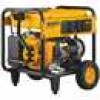Dewalt DXGNR7000 Instruction Manual - Page 16
Manual Start, Generator Shut Down, Low Oil Level Shutdown System - spark plug
 |
View all Dewalt DXGNR7000 manuals
Add to My Manuals
Save this manual to your list of manuals |
Page 16 highlights
Operation Manual Start The generator is equipped with a manual recoil starter which may be used if the battery is discharged. NOTICE: The switch must be in the Run position. Use one of the generator's receptacle outlets along with the included battery charger to charge the battery while the generator is running. To start manually: 1. Firmly grasp the recoil handle and pull slowly until increased resistance is felt. 2. Pull rapidly up and away to start engine. 3. Follow the same choke sequence. NOTICE: If engine fires, but does not continue to run, move choke lever to Full Choke and repeat starting instructions. IMPORTANT: Do not overload generator or individual panel receptacles. These outlets are overload protected with push-to-reset circuit breakers. If amperage rating of any circuit breaker is exceeded, that breaker opens and electrical output to that receptacle is lost. Read Know Generator Limits carefully. Generator Shut Down CAUTION Equipment and property damage. Disconnect electrical loads prior to start- ing or stopping unit. Failure to do so could result in equipment and property damage. 1. Shut off all loads and unplug electrical loads from generator panel receptacles. 2. Let engine run at no-load for several minutes to stabilize internal temperatures of engine and generator. 3. Move Run/Stop switch to Stop. 4. Close fuel valve. NOTICE: Under normal conditions, close fuel valve and allow generator to run carbure- tor bowl out of fuel. For emergencies, switch to Stop. Low Oil Level Shutdown System The engine is equipped with a low oil level sensor that shuts down the engine automatically when the oil level drops below a specified level. The engine will not run until the oil has been filled to the proper level. If the engine shuts down and there is sufficient fuel, check engine oil level. Charging the Battery (electric start units only) WARNING Explosion. Batteries emit explosive gases while charging. Keep fire and spark away. Wear protective gear when working with bat- teries. Failure to do so could cause death or serious injury. WARNING Risk of burns. Batteries contain sulfuric acid and can cause severe chemi- cal burns. Wear protective gear when working with batteries. Failure to do so could cause death or serious injury. NOTICE: The battery shipped with the generator has been fully charged. A battery may lose some of its charge when not in use for prolonged periods of time. If the battery is unable to crank the engine, plug in the 12V charger included in the accessory box. RUNNING THE GENERATOR DOES NOT CHARGE THE BATTERY. Use battery charger plug to keep the battery charged and ready for use. Battery charging should be done in a dry location. 1. Plug charger into Battery Charger Input jack, located on the control panel. Plug wall receptacle end of battery charger into 120 Volt AC wall outlet. 2. Unplug battery charger from wall outlet and control panel jack when generator is to be in use. NOTICE: Do not use the battery charger for more than 48 hours at one charge. "!44%29 #(!2'%2 ).054 000423 12 Owner's Manual for Portable Generator















